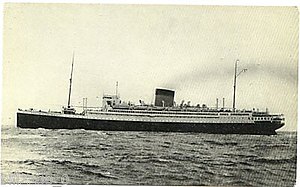SS De Grasse
 De Grasse in the 1950s, rebuilt with one funnel
| |
| History | |
|---|---|
| Name |
|
| Owner |
|
| Operator | 1953–1956: |
| Port of registry | |
| Route | 1924: Le Havre – New York |
| Builder | Cammell Laird, Birkenhead[1] |
| Yard number | 886 |
| Laid down | 23 March 1920 |
| Launched | 23 February 1924 |
| Completed | August 1924 |
| Maiden voyage | 21 August 1924 |
| In service | 1924 |
| Out of service | 1962 |
| Identification |
|
| Fate | Sank after ran aground, before scrap in 1962 |
| General characteristics [2] | |
| Type | Ocean liner |
| Tonnage | |
| Length | 552.1 ft (168.3 m)[2] |
| Beam | 71.4 ft (21.8 m) |
| Depth | 42.3 ft (12.9 m) |
| Decks | 4 |
| Propulsion | |
| Speed | 17 knots (31 km/h; 20 mph) |
SS De Grasse was a transatlantic liner built in 1921 by Cammell Laird, Birkenhead, United Kingdom for Compagnie Générale Transatlantique, and launched in February 1924. In August 1924 De Grasse set sail on her maiden voyage from Le Havre to New York. After the fall of France to Nazi Germany, the ship was used as a barracks ship. Sunk at Bordeaux, France, during the German retreat, she was refloated, repaired, and put back into service. Over the years, she became Empress of Australia and then Venezuela. She ran aground off Cannes, France, in 1962 and was scrapped at La Spezia, Italy.[3]
History
CGT

Originally speculated ordered under the name Suffren, the ship was renamed after the Compagnie Générale Transatlantique (CGT) acquired the Brazilian ship Leopoldina. De Grasse was put into service in August 1924 between Le Havre and New York.[1] It was modernized in 1931.
At the start of
The Germans partly sank it during their retreat in August 1944. It was refloated in August 1945 and sent to the Penhoët shipyards to be repaired and modernized (it lost a funnel during these transformations).[1] The ship was reassigned to the Le Havre to New York route while the CGT reconstituted a fleet.
Canadian Pacific

In 1953, De Grasse was sold to
Sicula Oceanica
In 1956, Empress of Australia was sold to Sicula Oceanica, and after a refit, the ship was renamed Venezuela and served the Naples to the Caribbean route. She had an uneventful career with her new owner.[4] In 1962, Venezuela was wrecked off Cannes. She was refloated but was broken up at La Spezia, Italy in August of the same year.[3]
Notable passengers
In April 1930 De Grasse transported Arturo Toscanini and the 114 members of the New York Philharmonic Orchestra from New York City to Le Havre on the outbound leg of the orchestra's first European tour.
In 1949,
See also
References
- ^ a b c d "De Grasse (I)". The Great Ocean Liners.
- ^ a b "SS. De Grasse". Relevant Search Scotland.[dead link]
- ^ a b "Brief Maritime History - De Grasse 1924". YouTube.
- ^ a b Haworth, R.B. Miramar Ship Index: ID #1185887[dead link]
- ^ Mah, Anne (23 June 2019). "A Year in Paris That Transformed Jacqueline Kennedy Onassis". The New York Times. Retrieved 30 December 2021.
Further reading
- Haworth, R.B. Miramar Ship Index: ID #1185887.
- Tate, E. Mowbray. (1986). Transpacific Steam: The Story of Steam Navigation from the Pacific Coast of North America to the Far East and the Antipodes, 1867-1941. New York: Cornwall Books. ISBN 978-0-8453-4792-8(cloth)
